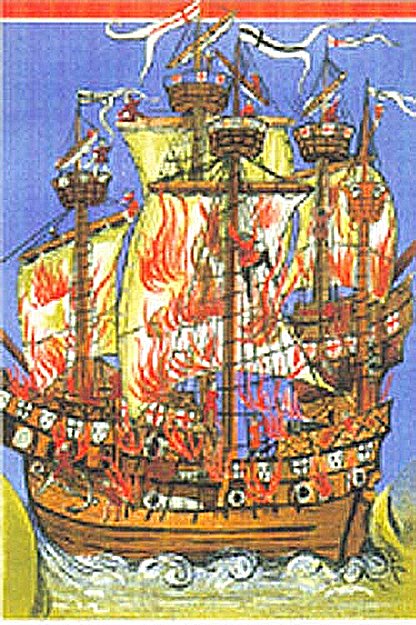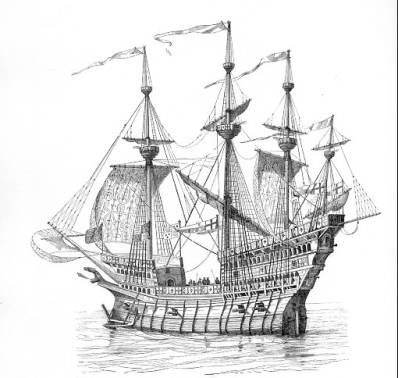Shipwrecks
diving into history
Marie la
Cordelière
Battle of Brest 1512
by Sarah Burbridge

All was going
rather well onboard the beautiful wooden sailing ships Marie
La Cordelière and Grande Louise.
It was the 10 August 1512 and a party was in full swing.
If the noise of the laughter ringing out across Plougonvelin bay, near
Brest, was anything to go by everyone was having a good time.
Three hundred local dignitaries and their spouses were being entertained
by the rather popular Marie La Cordelière
captain, privateer Hervé de Portzmoguer and the Grande Louise captain Vice Admiral René de Clermont.
The laughter wasn’t to last for long however as suddenly a fleet of
enemy English boats were spotted rounding the headland less than 2 miles
westward. Speed was of all
importance and there was no time to disembark the visiting gentry as the rest of
the fleet were alerted, anchors weighed and the guns made ready.
The English and French were practised foes and both sides engaged in battle
eagerly. Despite the relatively new
technology enjoyed by many of the boats (the Marie
La Cordelière for example was amongst the first boats to sport opening gun
ports aimed to accommodate the recent addition of cannon to fighting ships), the
emphasis of naval combat at that time was still very much on grappling and
boarding to conquer the enemy with hand to hand fighting.
The English fleet outnumbered the French by approximately 3 to 1 and
included the newly built 700 ton flagship Mary Rose, and two ships of 1000 tons, the Sovereign. Mary Rose started the cannon fire
and successfully hit Grande Louise resulting
in 300 dead within the first hour. The
700 ton Marie La Cordelière picked
on a smaller rival, the 400 ton Mary
James whose captain, Anthony Ughtred, did well at holding his own until help
from Sovereign arrived, followed by
the Regent.
With almost an hundred ships in the cramped channel, skilful captains
were required on both sides to work their men playing the wind and the tide in
order to gain windage and therefore advantage over their adversaries. As the
battle progressed the English appeared to have the upper hand until the much
esteemed Hervé de Portzmoguer concentrated his assault on the powerful enemy ship, the Regent,
eventually grappling her and boarding her.
The remaining vessels continued to fight in confusion, several being sunk
by cannon fire, some striking nearby rocks, and others retiring in disarray.
With the Regent and the Marie La Cordelière physically tied together
bitter hand to hand combat ensued. Arrow
and crossbow bolts were aimed but fighting conditions were made even harder as
the two ships rolled in the swell, their sides often crunching together
splintering wooden beams. Above
their heads flagging sails cracked louder than the sound of nearby cannon fire
as the wind caught them. Despite
Regent’s main mast being broken by a cannon ball and her wooden hull beginning
to burn as flaming projectiles were thrown by Marie La Cordelière’s crew, she
appeared to be the stronger of the two vessels. The fighting continued for more
than two hours and the decks became red as a mixture of blood and wine washed
over the once party boat. Hervé de Portzmoguer decided he had one last chance
to destroy the English vessel and he set his own powder magazine on fire thus
turning Marie La Cordelière into a
floating bomb. Within seconds there
was a violent explosion that instantly sank both ships.
Remaining vessels of both nationalities were shocked and stopped fighting
immediately in order to rescue any survivors.
Unfortunately not many survived this terrible spectacle - the English
commander, Thomas Knivet was killed by the explosion and Hervé de Portzmoguer was
thrown into the sea where he was drowned, dragged under by the weight of
his own armour. It is estimated that between 1000 and 2000 people lost their
lives with just 20 men rescued from the Marie La Cordelière and 180 from the
Regent.
It has never
been firmly established how many ships were sunk that day - BMRS continues to
search.... The battle itself
produced no clear victor, with the French and English fleets continuing their
sporadic engagements for years to come.

An artist’s impression of a typical16th
century galleon, in this case English. La
Cordelière probably closely resembled this design





